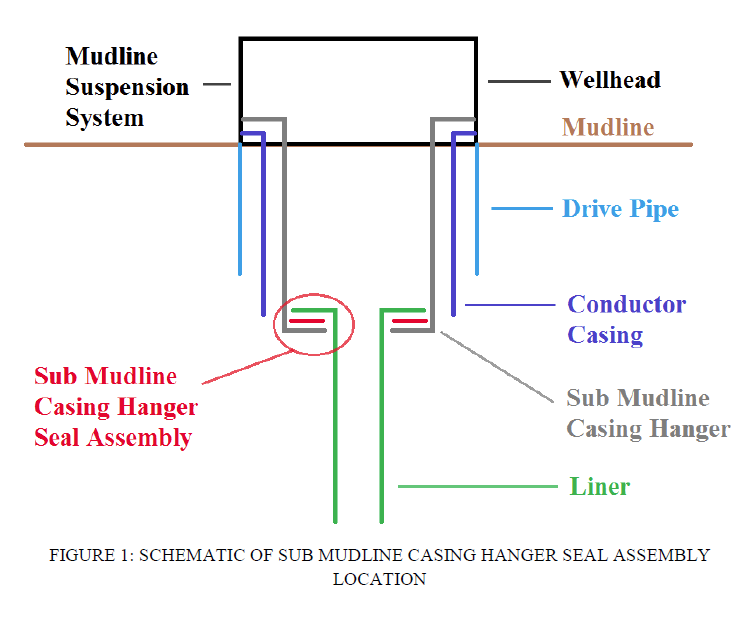EVALUATION OF SEAL ASSEMBLY AND CEMENT FAILURES. INTERIM SUMMARY OF FINDINGS
On February 10, 2013, a rig
was conducting drilling operations
on
Main Pass
Block 295 (“MP295”) in the Gulf of Mexico
(GOM), when an underground loss of well control
event occurred. The loss of well control
resulted in gas flow into a shallow sand, below the conductor
casing shoe in the well. This loss of well control
incident created a risk of broaching of the well to the
seafloor, which created
significant risks to the crew,
the rig, and the environment.
The well design included a dual barrier system in the annulus that should have prevented uncontrolled flow of hydrocarbons. The initial
review determined the dual barrier system failed, allowing gas flow to penetrate
a shallow formation
below the conductor
casing shoe. The first possible failure point was the sub mudline casing hanger seal assembly. This system was designed to hold pressure from the well up to the designated pressure and temperature ratings of the seal assembly. The second possible failure point was the cement column within the
conductor casing and surface casing annulus. The cement column should have created a barrier that prevents hydrocarbon flow from the well to the surrounding environment. Subsequent analysis indicated that there were several other potential points for failure which included damaged casing and/or damaged casing threads.
A Quality Control Failure Incident Team (QC-FIT)
was assembled to perform the following: conduct a technical
evaluation of the equipment involved in this incident to determine
if there were global quality assurance/quality control (QA/QC)
issues that needed
addressing by BSEE and/or industry issues related
to the use of the dual barrier systems. The goal of this report is to provide a general
assessment of industry equipment and engineering design related to these systems rather than making a definitive determination concerning the loss of well control
on MP295.
This technical evaluation includes a review
of available data, relevant
industry standards, and input from various
subject matter experts. A comprehensive recommendations list is outlined at the end of this report.
These recommendations are applicable to dual barrier seal systems
and equipment used in well
construction that serves as barriers.
Summarized key findings and
recommendations are:
·
Existing industry practices and BSEE regulations related to pressure
testing may not be adequate to evaluate
the integrity of either the seal assembly or the cement column. BSEE should consider modifying its regulations to ensure
that the integrity of these barriers can
be
verified after installation.
·
Operators should be required
to verify that any pressure containing equipment installed downhole has been designed, tested, and rated for any potential loss of well control condition
to which it might be exposed during
its service life.
·
A comprehensive analysis of well designs utilizing shallow liners and sub mudline casing
·
hangers
needs to be
performed by either BSEE or the industry to ensure that best engineering practices are being utilized
to minimize the risk of a loss of well control event.
A
liner is a casing string that does not extend to the top of the wellbore
(i.e. does not extend to the wellhead). It is suspended
from a previous casing string, by way of a
liner hanger. Therefore, a liner hanger
differs from a casing hanger, in that casing hangers are hung off directly from the wellhead
and liners are hung off casing strings via a liner hanger.
A mudline suspension system is an option for a bottom-supported rig (e.g. jack-up)
using a surface BOP, as in the case of this loss of well control event, in order to transfer
the weight of the well to the seabed.
When using mudline
suspension equipment, mudline
(or sub mudline,
if referring to equipment below the mudline)
casing hangers are used to provide suspension points for additional intermediate casing strings
that cannot be accommodated by a standard
conductor or wellhead housing
(as described in API 17D). An annulus seal assembly is a mechanism that provides pressure isolation between each casing hanger and the wellhead housing (also described in API 17D).
In the
case of this loss of well control event, the sub mudline casing hanger was hung off of the wellhead, as part of the mudline
suspension equipment system. The liner (referred to as a “shallow” liner, because it was hung off at a relatively shallow depth of approximately 703 feet below the mudline) was hung off of the sub mudline
casing hanger. The seal assembly
in question was at the interface where the shallow
liner is hung off of the sub mudline casing
hanger (also referred to as the liner top). The shallow liner is also the surface
casing in this case.
See Figure 1 for a schematic of the sub mudline casing
hanger seal used on this
well.




